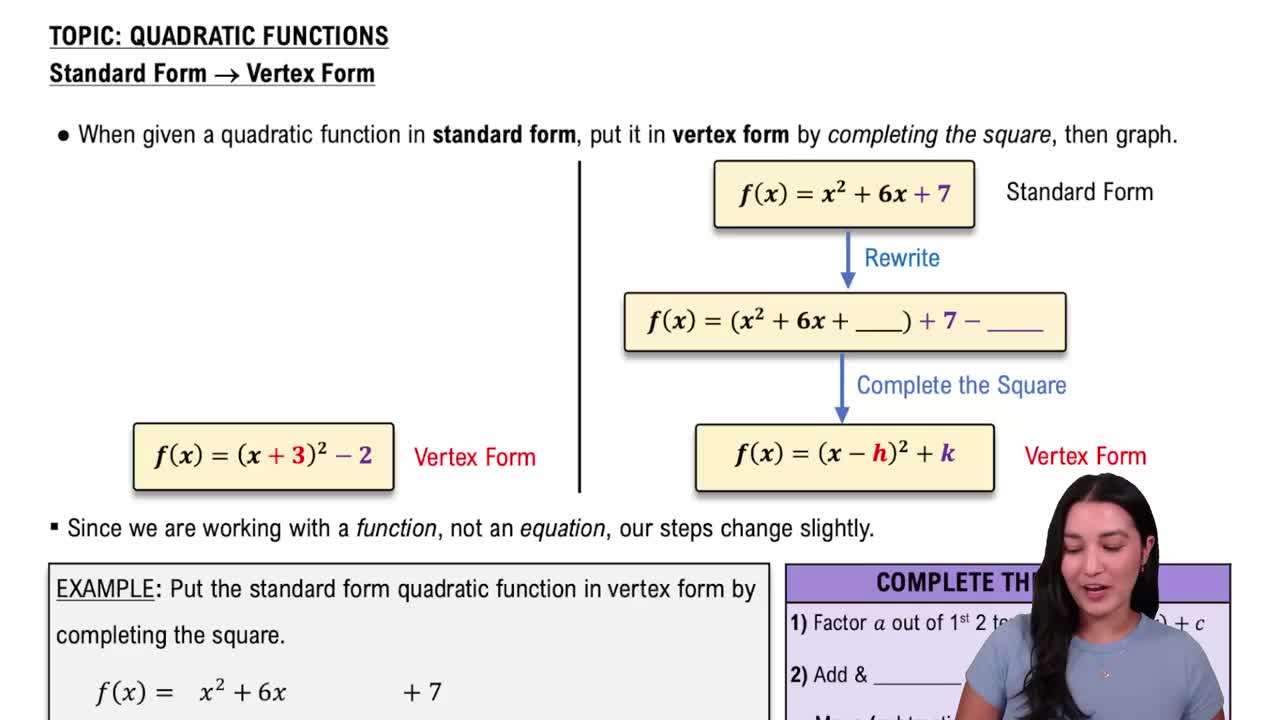Table of contents
- 0. Review of Algebra4h 16m
- 1. Equations & Inequalities3h 18m
- 2. Graphs of Equations43m
- 3. Functions2h 17m
- 4. Polynomial Functions1h 44m
- 5. Rational Functions1h 23m
- 6. Exponential & Logarithmic Functions2h 28m
- 7. Systems of Equations & Matrices4h 6m
- 8. Conic Sections2h 23m
- 9. Sequences, Series, & Induction1h 19m
- 10. Combinatorics & Probability1h 45m
4. Polynomial Functions
Quadratic Functions
Problem 86
Textbook Question
Textbook QuestionA quadratic equation ƒ(x) = 0 has a solution x = 2. Its graph has vertex (5, 3). What is the other solution of the equation?
 Verified Solution
Verified SolutionThis video solution was recommended by our tutors as helpful for the problem above
Video duration:
6mPlay a video:
Was this helpful?
Key Concepts
Here are the essential concepts you must grasp in order to answer the question correctly.
Quadratic Equations
A quadratic equation is a polynomial equation of the form ƒ(x) = ax² + bx + c, where a, b, and c are constants, and a ≠ 0. The solutions to this equation, also known as roots, can be found using various methods such as factoring, completing the square, or the quadratic formula. The graph of a quadratic equation is a parabola, which can open upwards or downwards depending on the sign of 'a'.
Recommended video:

Introduction to Quadratic Equations
Vertex of a Parabola
The vertex of a parabola is the highest or lowest point on its graph, depending on whether it opens downwards or upwards. For a quadratic function in standard form, the vertex can be found using the formula (-b/2a, ƒ(-b/2a)). In this case, the vertex is given as (5, 3), indicating that the parabola opens upwards and the maximum or minimum value occurs at this point.
Recommended video:

Horizontal Parabolas
Symmetry of Parabolas
Parabolas exhibit symmetry about a vertical line known as the axis of symmetry, which passes through the vertex. For a quadratic equation, if one root is known, the other root can be determined using the axis of symmetry. In this case, if one solution is x = 2 and the vertex is at x = 5, the other solution can be found by reflecting x = 2 across the axis of symmetry, leading to the conclusion that the other solution is x = 8.
Recommended video:

Horizontal Parabolas

 7:42m
7:42mWatch next
Master Properties of Parabolas with a bite sized video explanation from Callie
Start learningRelated Videos
Related Practice













